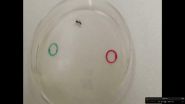When it comes to body odor, ants are connoisseurs
2015-08-13
(Press-News.org) For any complex society to function properly, individuals--be they people or social insects--must reliably recognize their friends and family with whom they live and work and readily distinguish those allies from strangers. Ants and other social insects manage this feat of recognition based on chemical pheromones, which are detected via sensors in their antennae. Now researchers reporting August 13 in Cell Reports have discovered that when it comes to assessing body odors, ants really don't miss a thing.
"To our surprise, these very low volatility compounds are not only detected sensitively by specialized antennal sensors, but almost all of the hydrocarbon components are detected," said Anandasankar Ray of the University of California, Riverside. "Using this amazing high-definition ability to smell 'ant body odor,' the ants can recognize the various castes in the colony as well as intruders from another colony."
This broad-spectrum ability to detect hydrocarbons is unusual and is probably a special property of social insects, the researchers say.
Ray and his colleagues employed a powerful electrophysiological method, which allowed them to systematically test the response of individual neurons in the ant antennae to hydrocarbons found in the cuticles of worker ants and their queens. Their method allowed them to determine exactly which chemicals triggered a response in the ants' sensory system, a level of detail that had never been achieved before.
The ants' high sensitivity to pheromones allows detection of very few molecules of hydrocarbons that stick close to the cuticle surface. This ability apparently allows individuals to recognize those ants that are very close to them within the crowded colony.
"This is a remarkable evolutionary solution for 'social networking' in large colonies," Ray explained. "A more volatile body odor cue would be confusing to associate with an individual and could overwhelm the olfactory system of the colony members by constantly activating it."
The researchers suggest that ants may be capable of responding not just to the presence or absence of particular hydrocarbons but also to the particular way in which various hydrocarbons are blended. In other words, pheromones might act as a kind of "chemical barcode," which individuals in a colony use to recognize other members within the nest and their status as workers or queens.
Perhaps ants are brainier than we've given them credit for, the researchers say. After all, their incredible talent for olfactory discrimination depends not only on sensitively attuned neurons and an impressive collection of odorant receptors--ants have the largest odorant receptor gene family known in insects, with the Camponotus floridanus ants in this study having more odorant receptors than humans do--but also on a remarkable ability to learn and differentiate between closely related hydrocarbons. As evidence of this, Ray and colleagues showed that ants were quick to associate particular hydrocarbons with a sugar reward. They could even discriminate amongst hydrocarbons that differ from one another only ever so slightly.
As they close in on the functional roles of the ants' odorant receptors, the researchers say they are particularly interested to find those that detect pheromones from the ant queen. Those cues from the queen are largely responsible for keeping the colony in order.
INFORMATION:
This work was funded by the Howard Hughes Medical Institute Hughes Collaboration Innovation Award. Anandasankar Ray is the founder and shareholder of Olfactor Labs, Inc., and Sensorygen, Inc. Both Ray and Laurence J. Zwiebel are listed as inventors in pending patent application by Vanderbilt University and University of California Riverside.
Cell Reports, Sharma et al.: "Cuticular Hydrocarbon Pheromones for Social Behavior and Their Coding in the Ant Antenna" http://dx.doi.org/10.1016/j.celrep.2015.07.031
Cell Reports, published by Cell Press, is a weekly open-access journal that publishes high-quality papers across the entire life sciences spectrum. The journal features reports, articles, and resources that provide new biological insights, are thought-provoking, and/or are examples of cutting-edge research. For more information, please visit http://www.cell.com/cell-reports. To receive media alerts for Cell Reports or other Cell Press journals, contactpress@cell.com.
[Attachments] See images for this press release:


ELSE PRESS RELEASES FROM THIS DATE:
2015-08-13
A link between malaria and Burkitt's lymphoma was first described more than 50 years ago, but how a parasitic infection could turn immune cells cancerous has remained a mystery. Now, in the August 13 issue of Cell, researchers demonstrate in mice that B cell DNA becomes vulnerable to cancer-causing mutations during prolonged combat against the malaria-causing Plasmodium falciparum.
Individuals who are chronically infected with certain pathogens are at increased risk of developing lymphomas, cancers of the antibody-producing B lymphocytes. For example, Burkitt's lymphoma, ...
2015-08-13
A study from the US National Institutes of Health presents some of the most precise human data yet on whether cutting carbs or fat has the most benefits for losing body fat. In a paper published August 13 in Cell Metabolism, the researchers show how, contrary to popular claims, restricting dietary fat can lead to greater body fat loss than carb restriction, even though a low-carb diet reduces insulin and increases fat burning.
Since 2003, Kevin Hall, PhD--a physicist turned metabolism researcher at the National Institute of Diabetes and Digestive and Kidney Diseases--has ...
2015-08-13
Irisin, a hormone linked to the positive benefits of exercise, was recently questioned to exist in humans. Two recent studies pointed to possible flaws in the methods used to identify irisin, with commercially available antibodies. In Cell Metabolism on August 13, the Harvard scientists who discovered irisin address this contentious issue by showing that human irisin circulates in the blood at nanogram levels and increases during exercise.
Senior study author Bruce Spiegelman of Dana-Farber Cancer Institute and Harvard Medical School says that the confusion over irisin ...
2015-08-13
The mechanisms that allow the liver to repair and regenerate itself have long been a matter of debate. Now researchers at University of California, San Diego School of Medicine have discovered a population of liver cells that are better at regenerating liver tissue than ordinary liver cells, or hepatocytes. The study, published August 13 in Cell, is the first to identify these so-called "hybrid hepatocytes," and show that they are able to regenerate liver tissue without giving rise to cancer. While most of the work described in the study was done in mouse models, the researchers ...
2015-08-13
In what appears to be an unexpected challenge to a long-accepted fact of biology, Johns Hopkins researchers say they have found that ribosomes -- the molecular machines in all cells that build proteins -- can sometimes do so even within the so-called untranslated regions of the ribbons of genetic material known as messenger RNA (mRNA).
"This is an exciting find that generates a whole new set of questions for researchers," says Rachel Green, Ph.D., a Howard Hughes Medical Institute investigator and professor of molecular biology and genetics at the Johns Hopkins University ...
2015-08-13
Researchers from the National Institute of Allergy and Infectious Diseases (NIAID), part of the National Institutes of Health, and their collaborators have developed an experimental, nanoparticle-based vaccine against Epstein-Barr virus (EBV) that can induce potent neutralizing antibodies in vaccinated mice and nonhuman primates. Microscopic particles, known as nanoparticles, are being investigated as potential delivery vehicles for vaccines. The scientists' findings suggest that using a structure-based vaccine design and self-assembling nanoparticles to deliver a viral ...
2015-08-13
In a recent study, restricting dietary fat led to body fat loss at a rate 68 percent higher than cutting the same number of carbohydrate calories when adults with obesity ate strictly controlled diets. Carb restriction lowered production of the fat-regulating hormone insulin and increased fat burning as expected, whereas fat restriction had no observed changes in insulin production or fat burning. The research was conducted at the National Institute of Diabetes and Digestive and Kidney Diseases (NIDDK), part of the National Institutes of Health. Results were published ...
2015-08-13
Engineers from the University of Sheffield have developed a novel technique to predict when bearings inside wind turbines will fail which could make wind energy cheaper.
The method, published in the journal Proceedings of the Royal Society A and developed by Mechanical Engineering research student Wenqu Chen, uses ultrasonic waves to measure the load transmitted through a ball bearing in a wind turbine. The stress on wind turbine is recorded and then engineers can forecast its remaining service life.
When a bearing is subject to a load, its thickness is reduced by ...
2015-08-13
Black-footed ferrets, a critically endangered species native to North America, have renewed hope for future survival thanks to successful efforts by a coalition of conservationists, including scientists at Lincoln Park Zoo, to reproduce genetically important offspring using frozen semen from a ferret who has been dead for approximately 20 years. The sire, "Scarface," as he is affectionately called by the team, was one of the last 18 black-footed ferrets to exist in the world in the 1980s. Eight kits, including offspring of Scarface, were born recently, significantly increasing ...
2015-08-13
One of the more heartbreaking realities of Alzheimer's is the moment when a loved one struggling with the disease no longer fully recognizes a family member or close friend who is caring for them.
Now, new research from Washington University in St. Louis has identified a novel learning and memory brain network that processes incoming information based on whether it's something we've experienced previously or is deemed to be altogether new and unknown, helping us recognize, for instance, whether the face before us is that of a familiar friend or a complete stranger.
Forthcoming ...
LAST 30 PRESS RELEASES:
[Press-News.org] When it comes to body odor, ants are connoisseurs




